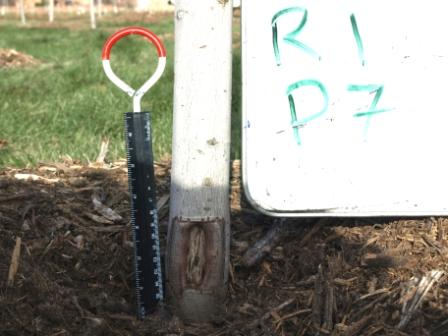After Linda’s post yesterday I just had to add my own 2 cents about gator bags. I use ’em and I like ’em. But, that said, I never allow gator bags to sit against trees for an extended period of time (Maybe 6 weeks when the tree first goes in). That’s just asking for trouble! But looking at those bags got me thinking about a project which we’re finishing up this year. Volcano mulching. Believe me, it sounds a lot cooler than it is. Volcano mulching is when you make a big pile of mulch along a tree’s trunk, as in the picture below.

The reason we’re looking at volcano mulching is that everyone says it’s bad, but no-one has really proven that it’s bad. The reasons that volcano mulching are supposed to be bad are twofold: First, the mulch could cause rot on the tree’s stem (as with those gator bags) and second, because it might be possible for a tree’s roots to grow up into the mulch, potentially surrounding the stem, which might lead to the roots choking the stem as the tree grows larger. Not a good situation. Anyway, early in 2007 we took a field of maples and cut squares in their trunks, as seen below, and then either did or didn’t mound up mulch around these tree’s stems.

What we expected to see was that, over time, the wounding and presence of a mulch volcano would lead to diseases in the stem. Instead what we found is that, for many of the trees, deeper mulch actually led to the wounds closing more rapidly. The image below is of a wound that was covered with mulch.

While this next image is of a wound that wasn’t covered with mulch.

Of course some of the wounds without mulch closed fine as well, as you can see in the next image. (Why isn’t anything ever cut and dried?)

So what does all this mean? Well, nothing yet. Research is a funny thing: it rarely gives you quick and easy answers. I won’t recommend mulch volcanoes because we still haven’t examined those roots that may enter the mulch and surround the stem. And before I say that the volcanoes didn’t affect stem rot in this study I want to take a closer look at those wounds by cross sectioning the tree which we’ll probably do this fall. Plus we’ve got to run statistics on all the different trees….. and then it would be great if someone else would take a stab at this study to confirm what we see…. I tell you what, nothing’s easy.





